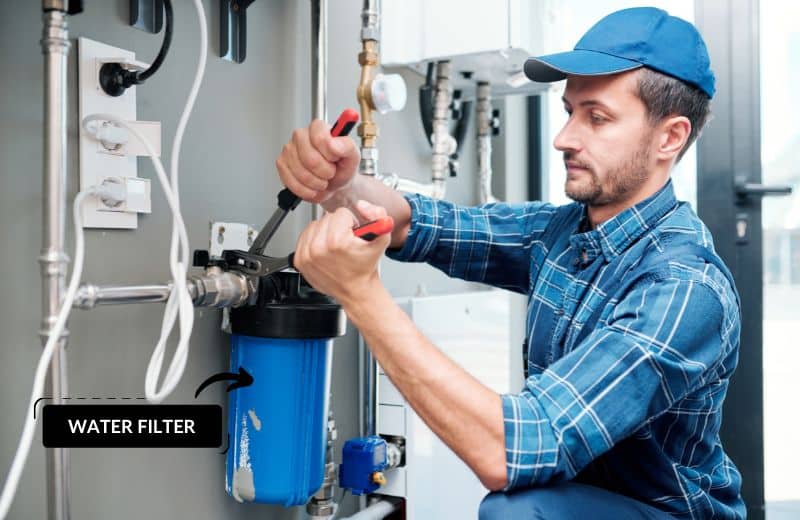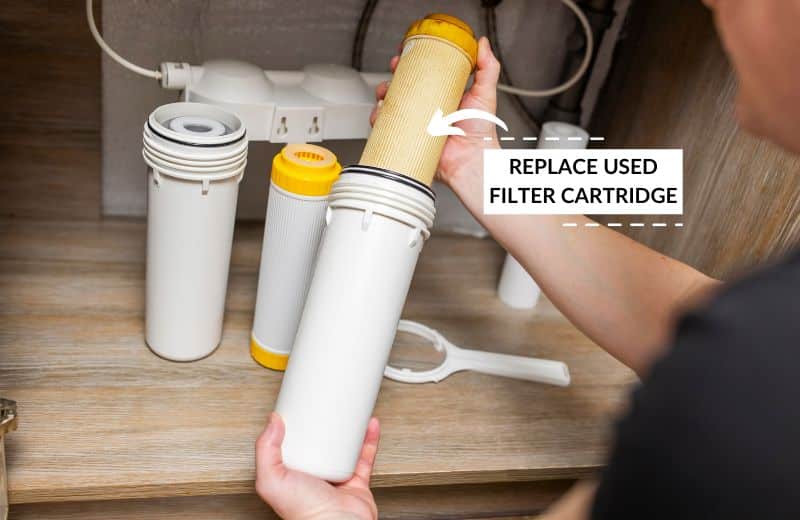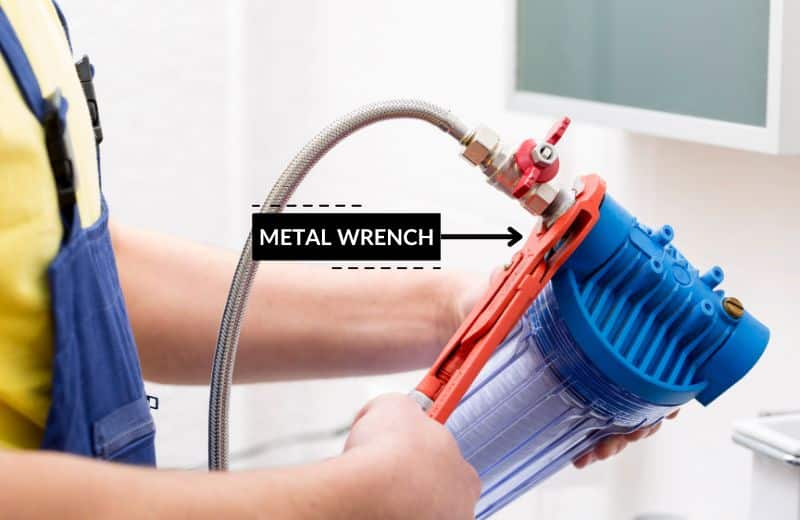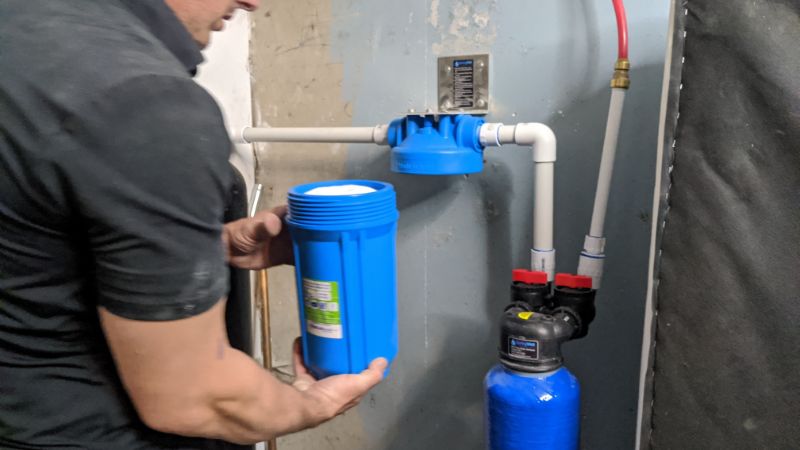What are the most common issues you’re likely to have with a whole house water filter? Have you encountered a problem with your filter and you’re wondering how to solve it?
You’ll find the most common whole house water filter problems – and how to solve them – in this guide.
📌 Key Takeaways:
- The most common issues with whole house water filters are leaking, trapped air, poor water tastes or smells, water pressure issues, stuck filter housing, and unusual noises from the filter.
- You can solve these issues by amending an installation error, replacing the filters, or flushing the filters, depending on the cause of the issue.
Table of Contents
🔩 6 Issues with Whole House Water Filters (& How To Solve Them)
Issue 1: Leaking Around Filter Housing
Leaking around the filter housing is the number one problem in whole house water filtration systems.
Leaks are most likely caused by an installation fault or an aging system. You might have failed to tighten the filter connections properly – or you might have overtightened them. Or, you might not have used enough plumber’s tape, or there could be a crack or gap in a connection making room for water to escape.
If you think your whole house water filtration system is leaking, feel around the system for water, or look for water droplets beneath the system.
✅ How To Resolve
Resolving a leak in a whole house water filter system depends on the location of the leak:
- Leaking filter housing – If the filter housing is properly installed and tightly fitted, it’s likely that the housing has degraded or become damaged. The easiest fix is to replace the entire housing. We don’t recommend simply plugging the leak, since this could void your warranty.
- Leaking valve – If you notice leaking around your filter valve, the most common cause is general wear and tear. You might be able to temporarily resolve the issue by tightening the connections, but the only effective long-term solution is to replace the valve.
- Leaking from top – A degraded o-ring may cause leaking from the top of your whole house filter system. This is easy enough to fix – just shut off your water supply, remove the filter, and clean or replace the o-ring.

Issue 2: Trapped Air In Filters
Trapped air is a common problem in a plumbing system. If you’ve ever turned on a faucet and noticed it sputtering for a couple of seconds before reaching a steady flow, you’ve probably experienced trapped air.
Trapped air somewhere along your plumbing system – or in the whole house water filter system itself – could cause irregularities in your water pressure, along with a banging or knocking noise in your plumbing.
While trapped air doesn’t affect the performance of your whole house filter or the quality of your filtered water supply, it can be annoying to deal with.
✅ How To Resolve
The best way to resolve an issue with trapped air in your whole house filtration system is to thoroughly flush the system by turning your faucet on full and leaving it for a few minutes.
In most scenarios, this should get rid of the trapped air and restore a consistent water supply. However, in some cases, you might have a more persistent problem that needs to be looked at by a plumber.
Issue 3: Poor Water Tastes Or Smells
The whole purpose of whole house filters is to improve water quality. So, if drinking water tastes or smells funny, there could be an underlying issue with your drinking tap water filter.
Poor water tastes or smells from your whole house filtration system are most likely caused by a clogged filter.
Once your filters reach the end of their lifespans, they’ll become gradually more and more clogged with contaminants. These contaminants may leach nasty tastes and odors into your tap water.
Mold and mildew may also develop in an old water filter, giving off a musty odor and dirty taste, affecting the quality of your drinking water.
✅ How To Resolve
Resolving an issue with poor tastes and smells is easy: just replace your filters. Make sure to replace your filters on time to keep your filtration system working as intended and prevent filter degradation, which could cause trapped contaminants to seep back into your water.
Check your filter’s user manual for information on filter lifespan and make a note in your calendar when new filters are needed. Your manufacturer might sell multipacks of filters at a lower cost per filter, which can help you save money in the long run.

Issue 4: Water Pressure Issues
There are a couple of causes of water pressure issues in your filtration system.
First, you might have bought a system that’s too small for your home. Most whole house systems come in multiple sizes, so you can choose the right size for the number of bathrooms in your home. Undersizing a water filtration system could mean that your water pressure is significantly reduced when it flows into the filter housings.
Another common cause of water pressure issues in a filter is clogged filters. As we mentioned above, all filters become clogged eventually. When this happens, the flow rate of water through the filter is reduced because there is more resistance from the trapped contaminants.
✅ How To Resolve
The best way to resolve water pressure issues caused by an undersized system is to buy the right-sized system. The best POE water filters have money-back guarantees that allow you to return them (and receive a full refund) within a certain trial period for any reason. Speak to the manufacturer about your water pressure issues and see if they can recommend a larger model for you.
Fixing a water pressure issue caused by clogged filters is much easier – just replace the clogged filters and your water pressure and flow should return to their former selves.
Issue 5: Stuck Filter Housing
Stuck filter housing happens when debris, limescale deposits, and contaminants from the filter jam the housing in place.
You might also have issues with a stuck filter housing if you overtightened the housing when you first installed the system. Or, you might have forgotten to depressurize the filter before attempting to remove the housing.
✅ How To Resolve
There are a few different methods of dealing with a stuck filter housing, including:
- Depressurizing the filter by pressing the pressure release button.
- Attempting to unscrew the filter housing with a filter wrench or tea towel (which gives a better grip than using your hands).
- Gently tapping the filter with a rubber mallet.
- Applying heat from a hairdryer or a towel soaked in hot water to loosen deposits and expand the plastic.
If all else fails, try using a metal wrench or rubber strap wrench, but be careful – these tools are strong and could crack your filter if you apply too much force.

Issue 6: Unusual Noises From Filter
There are a few unusual noises that you might detect after installing a whole house water filter. Some are normal noises that should clear up on their own, while others might point to an issue.
A whole house water filter system might emit a humming noise after it’s first installed, especially when plastic or PVC pipes are involved, because of their lightweight design. This noise should disappear after a few weeks.
A whining noise (either temporary or constant) suggests that your whole house system has too much pressure, but could also be a sign of a problem with a valve.
Hammering or sputtering is likely caused by trapped air inside the filters.
✅ How To Resolve
You can resolve any unusual noise by detecting the source of the noise and (if necessary) devising a solution to the problem.
For example, if you discover that the whining noise in your whole house water filtration system is caused by a faulty valve, you can repair or replace the valve to solve the issue.
Or, if there’s a sputtering noise caused by trapped air in your plumbing, try running a faucet for a few minutes. You might need to call a plumber if the trapped air issue persists.
🤔 Can A Whole House Water Filter Stop Working Entirely?
We’ve shared the most likely problems with whole house filtration systems above – but is it possible for a whole house filter to stop working entirely?
The answer is yes, it can appear so – but there’s usually still a detectable cause. So, don’t be so fast to throw out your filter and buy a whole new one.
For instance, if you’re getting no water from the whole house filter, it might be that a filter stage has become so badly clogged that water is unable to pass through.
You should be able to resolve this issue by removing the filter and thoroughly cleaning the filter housing, then replacing the filter cartridge.
Most whole house filtration systems don’t use electricity, but a few do. If your whole house water system connects to a power outlet, make sure that it hasn’t shut off due to a lack of power.
Whole house filters have a pretty basic design, so if you’re experiencing problems with filtered water production, there should be an easy fix. Contact your filter manufacturer if you’re unsure.
Time to upgrade? Find the perfect whole house water filter here

❔ Whole House Water Filter Problems: FAQ
Why is my whole house water filter not working?
Your whole house water filter might not be working if the filters aren’t properly installed, if the filters need to be replaced, or if the system is too small or big for your home. If you can’t troubleshoot the problem yourself, contact the manufacturer and ask for advice.
What are the common problems in filters?
The most common problems in water filters are clogged filter media (which could reduce flow rate and prevent proper contaminant removal), leaking from various parts of the unit, and stuck filter housing. You can resolve these issues by replacing the filters or using a suitable method to un-stick the filter.
Can water filters cause health issues?
No, water filters can’t cause health issues if they’re used properly. In fact, a water filtration system can actually prevent health issues associated with drinking water contaminants by removing these contaminants from your water. However, it’s essential to change the filters on time to prevent bacteria accumulation, which could make you sick.
Does a whole house water filter reduce flow?
Yes, it’s normal for a whole house water filter to reduce your flow rate – but not substantially. Let’s say your average whole home flow rate before installing a filter is 12 GPM (gallons per minute). A water filter should only reduce the flow rate by a few GPM – to around 9-10 GPM. If your water flow is reduced significantly, you might have bought a system that’s too small for your home, or you might need to replace the filters.

put a new filter in my whole house filter system and the new filter doesn’t fit right and it is the same type.
Why?
Did you check that the o-ring is seated properly?
What is wrong if the new filter will not stay in place?
Is this a cartridge system you are referring to? Did you removed the old o-ring on top of the cartridge housing and replace it with a new one? Did you try to screw it back into place with a new o-ring without pulling out the old one? Is the o-ring lubricated?
Great article! Here is a question. I have a small municipal ground water well system supplying water to my house. The water has extremely high level of Dissolved Oxygen (DO) where it causes constant sputtering out of facets and water heater and will look milky in a bowl because of all the air bubble. Problem is that the DO level is generating a high amount of Ferric Iron from Ferrous Iron in the well source water, staining toilets and clogging fridge water filter. The PH is on the lower side 6-6.5 and the water smells and tastes metallic If I put a whole house filtration system to correct the Iron and possibly the PH issue will the high DO levels impact the filtartion systems performance and operation? thanks.
Nope, in fact many systems used to treat ferrous iron actually inject air into the water in order to oxidize the iron then filter it out (also known as air injection oxidation). Treating the acidic imbalance would then be accomplished downstream (after the iron filter) with a ph neutralizer employing some type of calcite media.